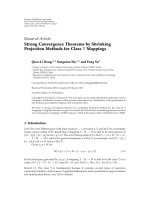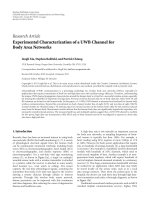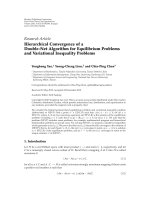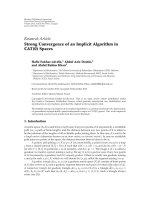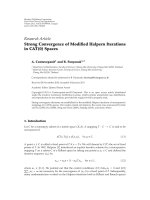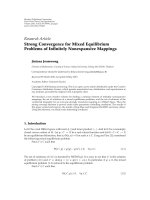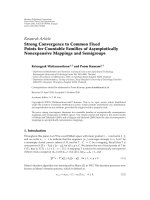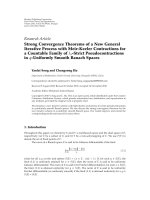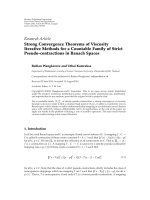Báo cáo hóa học: "Research Article Strong Convergence of an Iterative Method for Equilibrium Problems and Variational Inequality Problems" docx
Bạn đang xem bản rút gọn của tài liệu. Xem và tải ngay bản đầy đủ của tài liệu tại đây (552.17 KB, 21 trang )
Hindawi Publishing Corporation
Fixed Point Theory and Applications
Volume 2009, Article ID 362191, 21 pages
doi:10.1155/2009/362191
Research Article
Strong Convergence of an Iterative
Method for Equilibrium Problems and
Variational Inequality Problems
HongYu Li
1
and HongZhi Li
2
1
Department of Mathematics, TianJin Polytechnic University, TianJin 300160, China
2
Department of Mathematics, Agricultural University of Hebei, BaoDing 071001, China
Correspondence should be addressed to HongYu Li, lhy
Received 26 August 2008; Revised 11 November 2008; Accepted 9 January 2009
Recommended by Massimo Furi
We introduce an iterative method for finding a common element of the set of solutions of
equilibrium problems, the set of solutions of variational inequality problems, and the set of fixed
points of finite many nonexpansive mappings. We prove strong convergence of the iterative
sequence generated by the proposed iterative algorithm to the unique solution of a variational
inequality, which is the optimality condition for the minimization problem.
Copyright q 2009 H. Li and H. Li. This is an open access article distributed under the Creative
Commons Attribution License, which permits unrestricted use, distribution, and reproduction in
any medium, provided the original work is properly cited.
1. Introduction
Let H be a real Hilbert space with inner product ·, ·and norm ·, respectively. Suppose
that C is nonempty, closed convex subset of H and F is a bifunction from C × C to R, where
R is the set of real number. The equilibrium problem is to find a x ∈ C such that
Fx, y ≥ 0, ∀y ∈ C. 1.1
The set of such solutions is denoted by EPf. Numerous problems in physics, optimization,
and economics reduce to find a solution of equilibrium problem. Some methods have been
proposed to solve the equilibrium problems in Hilbert space, see, for instance, Blum and
Oettli 1, Combettes and Hirstoaga 2, and Moudafi 3.
A mapping A : C → H is called monotone if Au − Av, u − v≥0. A is called relaxed
u, v-cocoercive, if there exist constants u>0andv>0 such that
Ax − Ay, x − y≥−uAx − Ay
2
vx − y
2
, ∀x, y ∈ C, 1.2
2 Fixed Point Theory and Applications
when u 0, A is called v-strong monotone; when v 0, A is called relaxed u-cocoercive.
Let A : C → H be a monotone operator, the variational inequality problem is to find a point
u ∈ C, such that
Au, v − u≥0, ∀v ∈ C. 1.3
The set of solutions of variational inequality problem is denoted by VIC, A. The variational
inequality problem has been extensively studied in literatures, see, for example, 4, 5 and
references therein.
Let B be a strong positive bounded linear operator on H with coefficient
γ,thatis,
there exists a constant
γ>0 such that Bx, x≥γx
2
, for all x ∈ H. A typical problem is to
minimize a quadratic function over the set of the fixed points of a nonexpansive mapping on
a real Hilbert space H:
min
x∈FT
Ax, x−x, b, 1.4
where T is a nonexpansive mapping on H and b is a point on H.
A mapping T from C into itself is called nonexpansive, if Tx−Ty≤x−y, ∀x, y ∈ C.
The set of fixed points of T is denoted by FT.Let{T
i
}
N
i1
be a finite family of nonexpansive
mappings and F
N
i1
FT
i
/
∅, define the mappings
U
n,1
λ
n,1
T
1
1 − λ
n,1
I,
U
n,2
λ
n,2
T
2
U
n,1
1 − λ
n,2
I,
.
.
.
U
n,N−1
λ
n,N−1
T
N−1
U
n,N−2
1 − λ
n,N−1
I,
W
n
U
n,N
λ
n,N
T
N
U
n,N−1
1 − λ
n,N
I,
1.5
where {λ
n,i
}
N
i1
⊂ 0, 1 for all n ≥ 1. Such a mapping W
n
is called W-mapping generated by
T
1
,T
2
, ,T
N
and {λ
n,i
}
N
i1
. We know that W
n
is nonexpansive and FW
n
N
i1
FT
i
,see6.
Let S : C → C be a nonexpansive mapping and f : C → C is a contractive with
coefficient α ∈ 0, 1.MarinoandXu7 considered the following general iterative scheme:
x
n1
α
n
γf
x
n
1 − α
n
B
Sx
n
. 1.6
They proved that {x
n
} converges strongly to z P
FS
I − B γfz, where P
FS
is the metric
projection from H onto FS.
Fixed Point Theory and Applications 3
By combining equilibrium problems and 1.6, Plutbieng and Pumpaeng 8 proposed
the following algorithm:
F
u
n
,y
1
r
n
y − u
n
,u
n
− x
n
≥ 0, ∀y ∈ H,
x
n1
α
n
γf
x
n
I − α
n
B
Su
n
.
1.7
They proved that if the sequences {α
n
} and {r
n
} satisfy some appropriate conditions, then
sequence {x
n
} convergence to the unique solution z of the variational inequality
B − γfz, x − z
≥ 0, ∀x ∈ FS ∩ EPF. 1.8
Motivated by 8, Colao et al. 9 introduced an iterative method for equilibrium problem
and finite family of nonexpansive mappings
F
u
n
,y
1
r
n
y − u
n
,u
n
− x
n
≥ 0, ∀y ∈ H,
x
n1
α
n
γf
x
n
βx
n
1 − βI − α
n
B
W
n
u
n
,
1.9
and proved that {x
n
} converges strongly to a point x
∗
∈ F ∩ EPF and x
∗
also solves the
variational inequality 1.8. For equilibrium problems, also see 10, 11.
On the other hand, let A : C → C be a α-cocoercive mapping, for finding common
element of the solution of variational inequality problems and the set of fixed point of
nonexpansive mappings, Takahashi and Toyoda 12 introduced iterative scheme
x
n1
α
n
x
n
1 − α
n
SP
C
I − λ
n
A
x
n
. 1.10
They proved that {x
n
} converges weakly to z ∈ FS ∩ VIC, A. Inspired by 1.10 and 13,
Y. Yao and J C. Yao 14 given the following iterative process:
y
n
P
C
I − λ
n
A
x
n
,
x
n1
α
n
u β
n
x
n
γ
n
SP
C
I − λ
n
A
y
n
,
1.11
and proved that {x
n
} converges strongly to z ∈ FS ∩ VIC, A. By combining viscosity
approximation method and 1.10, Chen et al. 15 introduced the process
x
n1
α
n
f
x
n
β
n
SP
C
I − λ
n
A
x
n
, 1.12
4 Fixed Point Theory and Applications
and studied the strong convergence of sequence {x
n
} generated by 1.12. Motivated by 1.6,
1.11,and1.12, Qin et al. 16 introduced the following general iterative process
y
n
P
C
I − s
n
A
x
n
,
x
n1
α
n
γf
W
n
x
n
I − α
n
B
W
n
P
C
I − t
n
A
y
n
,
1.13
and established a strong convergence theorem of {x
n
} to an element of
N
i1
FT
i
∩ VIC, A.
The purpose of this paper is to introduce the iterative process: x
1
∈ H and
Fu
n
,y
1
r
n
y − u
n
,u
n
− x
n
≥ 0, ∀y ∈ C,
y
n
b
n
u
n
1 − b
n
W
n
P
C
I − s
n
A
u
n
,
x
n1
α
n
γf
W
n
x
n
βx
n
1 − βI − α
n
B
W
n
P
C
I − t
n
A
y
n
,
1.14
where W
n
is defined by 1.5, A is u, v-cocoercive, and B is a bounded linear operator. We
should show that the sequences {x
n
} converge strongly to an element of
N
i1
FT
i
∩VIC, A∩
EPF. Our result extends the corresponding results of Qin et al. 16 and Colao et al. 9,and
many others.
2. Preliminaries
Let H be a real Hilbert space and C a nonempty, closed convex subset of H. We denote strong
convergence of {x
n
} to x by x
n
→ x and weak convergence by x
n
x.LetP
C
: C → H
is a mapping such that for every point x ∈ H, there exists a unique P
C
x ∈ C satisfying
x − P
C
x≤x − y, for all y ∈ C. P
C
is called the metric projection of H onto C. It is known
that P
C
is a nonexpansive mapping from H onto C. It is also known that P
C
x ∈ C and
x − P
C
x, P
C
x − y
≥ 0, ∀x ∈ H, y ∈ C, 2.1
x − y, P
c
x − P
C
y
≥
P
C
x − P
C
y
2
, ∀x, y ∈ H. 2.2
Let A : C → H be a monotone mapping of C into H, then u ∈ VIC, A if and only if
u P
C
u − λAu, for all λ>0. The following result is useful in the rest of this paper.
Lemma 2.1 see 17. Assume {a
n
} is a sequence of nonegative real number such that
a
n1
≤
1 − α
n
a
n
δ
n
, ∀n ≥ 0, 2.3
where {α
n
} is a sequence in 0, 1, and {δ
n
} is a sequence in R such that
1
∞
n0
α
n
∞,
2 lim sup
n →∞
δ
n
/α
n
≤ 0 or
∞
n0
|δ
n
| < ∞.
Then, lim
n →∞
a
n
0.
Fixed Point Theory and Applications 5
Lemma 2.2 see 18. Let {x
n
}, {u
n
} be bounded sequences in Banach space E satisfying x
n1
τ
n
x
n
1 − τ
n
u
n
for all n ≥ 0 and lim inf
n →∞
u
n1
− u
n
−x
n1
− x
n
≤ 0.Letτ
n
be a sequence
in 0, 1 with 0 < lim inf
n →∞
τ
n
≤ lim sup
n →∞
τ
n
< 1. Then, lim
n →∞
x
n
− u
n
0.
Lemma 2.3. For all x, y ∈ H, there holds the inequality
x y≤x
2
2y, x y. 2.4
Lemma 2.4 see 7. Assume that A is a strong positive linear bounded operator on a Hilbert space
H with coefficient
γ>0 and 0 <ρ≤A
−1
.ThenI − ρA≤1 − ργ.
For solving the equilibrium problem for a bifunction F : C × C → R, we assume that
F satisfies the following conditions:
A1 Fx, x0 for all x ∈ C;
A2 F is monotone: Fx, yFy, x ≤ 0 for all x, y ∈ C;
A3 for all x, y, z ∈ C, lim sup
t↓0
Ftz 1 − tx, y ≤ Fx, y;
A4 for all x ∈ C, Fx, · is convex and lower semicontinuous.
The following result is in Blum and Oettli 1.
Lemma 2.5 see 1. Let C be a nonempty closed convex subset of a Hilbert space E,letF be a
bifunction from C × C into R satisfying (A1)–(A4), let r>0, and let x ∈ H. Then there exists z ∈ C
such that
Fz, y
1
r
y − z, z − x≥0, ∀y ∈ C. 2.5
We also know the following lemmas.
Lemma 2.6 see 19. Let C be a nonempty closed convex subset of Hilbert space H,letF be a
bifunction from C × C to R satisfying (A1)–(A4), let r>0, and let x ∈ H, define a mapping T
r
:
H → C as follows:
T
r
x
z ∈ C : Fz, y
1
r
y − z, z − x≥0, ∀y ∈ C
, 2.6
for all x ∈ H. Then, the following holds:
1 T
r
is single-valued;
2 T
r
is firmly nonexpansive-type mapping, that is, for all x, y ∈ H,
T
r
x − T
r
y
2
≤
T
r
x − T
r
y, x − y
; 2.7
3 FT
r
EPF;
4 EPF is closed and convex.
6 Fixed Point Theory and Applications
A monotone operator T : H → 2
H
is said to be maximal monotone if its graph GT
{u, v : v ∈ Tu} is not properly contained in the graph of any other monotone operators. Let
A be a monotone mapping of C into H and let N
C
v be the normal cone for C at a point
v ∈ C,thatis
N
C
v
x ∈ H : v − y, x≥0, ∀y ∈ C
. 2.8
Define
Tv
⎧
⎨
⎩
Av N
C
v,v∈ C,
∅,v
/
∈ C.
2.9
It is known that in this case T is maximal monotone, and 0 ∈ Tv if and only if v ∈ VIC, A.
3. Strong Convergence Theorem
Theorem 3.1. Let H be a real Hilbert space and C be a nonempty closed convex subset of H. {T
i
}
N
i1
a finite family of nonexpansive mappings from C into itself and F : C × C → R a bifunction satisfying
(A1)–(A4). Let A : C → H be relaxed u, v-cocoercive and μ-Lipschitzian. Let f : C → C be an
α-contraction with 0 ≤ α<1 and B a strong positive linear bounded operator with coefficient
γ>0,
γ is a constant with 0 <γ<
γ/α. Let sequences {α
n
}, {b
n
} be in 0, 1 and {r
n
} be in 0, ∞, β is a
constant in 0, 1. Assume C
0
N
i1
FT
i
∩ VIC, A ∩ EPF
/
∅ and
i lim
n →∞
α
n
0,
∞
n1
α
n
∞;
ii lim
n →∞
|r
n1
− r
n
| 0, lim inf
n →∞
r
n
> 0;
iii {s
n
}, {t
n
}∈a, b for some a, b with 0 ≤ a ≤ b ≤ 2v − uμ
2
/μ
2
and lim
n →∞
|s
n1
−s
n
|
lim
n →∞
|t
n1
− t
n
| 0;
iv lim
n →∞
|λ
n1
− λ
n
| lim
n →∞
|b
n1
− b
n
| 0.
Then the sequence {x
n
} generated by 1.14 converges strongly to x
∗
∈ C
0
and x
∗
solves the
variational inequality x
∗
P
C
0
I − B − γfx
∗
, that is,
γfx
∗
− Bx
∗
,x− x
∗
≤ 0, ∀x ∈ C
0
. 3.1
Proof. Without loss of generality, we can assume α
n
≤ 1 − βB
−1
. Then from Lemma 2.4 we
know
1 − βI − α
n
B
1 − β
I −
α
n
1 − β
B
≤ 1 − β
1 −
α
n
1 − β
γ
1 − β − α
n
γ. 3.2
Since A is relaxed u, v-cocoercive and μ-Lipschitzian and iii holds, we know from 14
that for all x, y ∈ C and n ≥ 1, the following holds:
I − s
n
A
x −
I − s
n
A
y
≤x − y,
I − t
n
A
x −
I − t
n
A
y
≤x − y.
3.3
Fixed Point Theory and Applications 7
We divide the proof into several steps.
Step 1. {x
n
} is bounded.
Take p ∈ C
0
,noticethatu
n
T
r
n
x
n
and form Lemma 2.62 that T
r
n
is nonexpansive,
we have
u
n
− p
T
r
n
x
n
− T
r
n
p
≤
x
n
− p
. 3.4
Since p W
n
P
C
p − s
n
Ap, we have
y
n
− p
b
n
u
n
1 − b
n
W
n
P
C
u
n
− s
n
Au
n
− p
≤ b
n
u
n
− p
1 − b
n
W
n
P
C
u
n
− s
n
Au
n
− p
≤ b
n
u
n
− p
1 − b
n
u
n
− s
n
Au
n
−
p − s
n
Ap
≤ b
n
u
n
− p
1 − b
n
u
n
− p
≤
x
n
− p
.
3.5
Then we have
x
n1
− p
α
n
γf
W
n
x
n
βx
n
1 − βI − α
n
B
W
n
P
C
I − t
n
A
y
n
− p
α
n
γf
W
n
x
n
− Bp
β
x
n
− p
1 − βI − α
n
B
W
n
P
C
I − t
n
A
y
n
− p
α
n
γf
W
n
x
n
− Bp
β
x
n
− p
1 − β − α
n
γ
y
n
− p
.
3.6
Thus From 3.5 we have
x
n1
− p
≤ α
n
γ
f
W
n
x
n
− f
p
α
n
γfp − Bp
β
x
n
− p
1 − β − α
n
γ
x
n
− p
≤ α
n
γα
x
n
− p
α
n
γfp − Bp
1 − α
n
γ
x
n
− p
1 − α
n
γ − αγ
x
n
− p
α
n
γfp − Bp
1 − α
n
γ − αγ
x
n
− p
α
n
γ − αγ ·
γf
p
− Bp
γ − αγ
≤ max
x
n
− p
,
γf
p
− Bp
γ − αγ
≤ max
x
1
− p
,
γf
p
− Bp
γ − αγ
,
3.7
hence {x
n
} is bounded, so is {u
n
}, {y
n
}.
8 Fixed Point Theory and Applications
Step 2. lim
n →∞
x
n1
− x
n
0.
Let x
n1
βx
n
1 − βz
n
, for all n ≥ 0, where
z
n
1
1 − β
α
n
γf
W
n
x
n
1 − βI − α
n
B
W
n
P
C
y
n
− t
n
Ay
n
. 3.8
Then we have
z
n1
− z
n
1
1 − β
γ
α
n1
f
W
n1
x
n1
− α
n
f
W
n
x
n
1 − βI − α
n1
B
W
n1
P
C
y
n1
− t
n1
Ay
n1
−
1 − βI − α
n
B
W
n
P
C
y
n
− t
n
Ay
n
γ
1 − β
α
n1
f
W
n1
x
n1
− α
n
f
W
n
x
n
W
n1
P
C
y
n1
− t
n1
Ay
n1
− W
n
P
C
y
n
− t
n
Ay
n
−
1
1 − β
α
n1
BW
n1
P
C
y
n1
− t
n1
Ay
n1
− α
n
BW
n
P
C
y
n
− t
n
Ay
n
≤
W
n1
P
C
y
n1
− t
n1
Ay
n1
− W
n1
P
C
y
n
− t
n1
Ay
n
W
n1
P
C
y
n
− t
n1
Ay
n
− W
n1
P
C
y
n
− t
n
Ay
n
W
n1
P
C
y
n
− t
n
Ay
n
− W
n
P
C
y
n
− t
n
Ay
n
K
1
,
3.9
where
K
1
α
n1
1 − β
γ
f
W
n1
x
n1
BW
n1
P
C
y
n1
− t
n1
Ay
n1
α
n
1 − β
γ
f
W
n
x
n
BW
n
P
C
y
n
− t
n
Ay
n
.
3.10
Next we estimate W
n1
P
C
y
n1
−t
n1
Ay
n1
−W
n1
P
C
y
n
−t
n1
Ay
n
, W
n1
P
C
y
n
−t
n1
Ay
n
−
W
n1
P
C
y
n
− t
n
Ay
n
and W
n1
P
C
y
n
− t
n
Ay
n
− W
n
P
C
y
n
− t
n
Ay
n
.Atfirst
W
n1
P
C
y
n
− t
n1
Ay
n
− W
n1
P
C
y
n
− t
n
Ay
n
≤
t
n
Ay
n
− t
n1
Ay
n
t
n1
− t
n
·
Ay
n
.
3.11
Fixed Point Theory and Applications 9
Put v
n
P
C
y
n
− t
n
Ay
n
, we have
W
n1
P
C
y
n
− t
n
Ay
n
− W
n
P
C
y
n
− t
n
Ay
n
W
n1
v
n
− W
n
v
n
U
n1,N
v
n
− U
n,N
v
n
λ
n1,N
T
N
U
n1,N−1
v
n
1 − λ
n1,N
v
n
− λ
n,N
T
N
U
n,N−1
v
n
−
1 − λ
n,N
v
n
≤
λ
n1,N
T
N
U
n1,N−1
v
n
− λ
n,N
T
N
U
n,N−1
v
n
λ
n1,N
− λ
n,N
·
v
n
≤ λ
n1,N
U
n1,N−1
v
n
− U
n,N−1
v
n
λ
n1,N
− λ
n,N
·
T
N
U
n,N−1
v
n
λ
n1,N
− λ
n,N
·
v
n
≤
U
n1,N−1
v
n
− U
n,N−1
v
n
λ
n1,N
− λ
n,N
T
N
U
n,N−1
v
n
v
n
.
3.12
By recursion we get
W
n1
P
C
y
n
− t
n
Ay
n
− W
n
P
C
y
n
− t
n
Ay
n
≤ M ·
N
i1
λ
n1,i
− λ
n,i
, 3.13
for some M>0. Similarly, we also get
W
n1
P
C
u
n
− s
n
Au
n
− W
n
P
C
u
n
− s
n
Au
n
≤ M ·
N
i1
λ
n1,i
− λ
n,i
. 3.14
Since
F
u
n
,y
1
r
n
y − u
n
,u
n
− x
n
≥ 0, ∀y ∈ C,
F
u
n1
,y
1
r
n1
y − u
n1
,u
n1
− x
n1
≥ 0, ∀y ∈ C.
3.15
Put y u
n1
in the first inequality and y u
n
in the second one, we have
F
u
n
,u
n1
1
r
n
u
n1
− u
n
,u
n
− x
n
≥ 0,
F
u
n1
,u
n
1
r
n1
u
n
− u
n1
,u
n1
− x
n1
≥ 0.
3.16
Adding both inequality, by A2 we have
u
n1
− u
n
,
1
r
n
u
n
− x
n
−
1
r
n1
u
n1
− x
n1
≥ 0, 3.17
10 Fixed Point Theory and Applications
therefore, we have
u
n1
− u
n
,u
n
− u
n1
x
n1
− x
n
r
n1
− r
n
r
n1
u
n1
− x
n1
≥ 0, 3.18
which implies that
u
n1
− u
n
2
≤
u
n1
− u
n
,
x
n1
− x
n
r
n1
− r
n
r
n1
u
n1
− x
n1
≤
u
n1
− u
n
·
x
n1
− x
n
|r
n1
− r
n
|
r
n1
u
n1
− x
n1
.
3.19
Hence we have
u
n1
− u
n
≤
x
n1
− x
n
|r
n1
− r
n
|
r
n1
u
n1
− x
n1
, 3.20
so, by 3.20 and the property I − t
n
Ax − I − t
n
Ay≤x − y, we arrive at
W
n1
P
C
y
n1
− t
n1
Ay
n1
− W
n1
P
C
y
n
− t
n1
Ay
n
≤
y
n1
− y
n
b
n1
u
n1
1 − b
n1
W
n1
P
C
I − s
n1
A
u
n1
− b
n
u
n
−
1 − b
n
W
n
P
C
I − s
n
A
u
n
b
n1
u
n1
− u
n
b
n1
− b
n
u
n
1 − b
n1
W
n1
P
C
u
n1
− s
n1
Au
n1
− W
n1
P
C
u
n
− s
n1
Au
n
1 − b
n1
W
n1
P
C
u
n
− s
n1
Au
n
− W
n1
P
C
u
n
− s
n
Au
n
×
1 − b
n1
W
n1
P
C
u
n
− s
n
Au
n
− W
n
P
C
u
n
− s
n
Au
n
b
n
− b
n1
W
n
P
C
u
n
− s
n
Au
n
≤ b
n1
u
n1
− u
n
|b
n1
− b
n
|·
u
n
1 − b
n1
u
n1
− u
n
1 − b
n1
|s
n
− s
n1
|·
Au
n
1 − b
n1
W
n1
P
C
u
n
− s
n
Au
n
− W
n
P
C
u
n
− s
n
Au
n
b
n
− b
n1
·
W
n
P
C
u
n
− s
n
Au
n
u
n1
− u
n
1 − b
n1
W
n1
P
C
u
n
− s
n
Au
n
− W
n
P
C
u
n
− s
n
Au
n
K
2
,
3.21
Fixed Point Theory and Applications 11
where
K
2
:
1 − b
n1
s
n
− s
n1
·
Au
n
b
n1
− b
n
W
n
P
C
u
n
− s
n
Au
n
v
n
. 3.22
Therefore, by 3.14 and 3.20 we get
W
n1
P
C
y
n1
− t
n1
Ay
n1
− W
n1
P
C
y
n
− t
n1
Ay
n
≤
x
n1
− x
n
|r
n1
− r
n
|
r
n1
u
n1
− x
n1
1 − b
n1
M ·
N
i1
λ
n1,i
− λ
n,i
K
2
.
3.23
Now submitting 3.11, 3.13,and3.23 into 3.9, we have
z
n1
− z
n
x
n1
− x
n
|r
n1
− r
n
|
r
n1
u
n1
− x
n1
1 − b
n1
M ·
N
i1
λ
n1,i
− λ
n,i
K
2
t
n1
− t
n
·
Ay
n
M ·
N
i1
λ
n1,i
− λ
n,i
K
1
.
3.24
Thus conditions ii, iii,andiv imply that
lim sup
n →∞
z
n1
− z
n
−
x
n1
− x
n
≤ 0. 3.25
Then, Lemma 2.2 yields
lim
n →∞
x
n1
− x
n
lim
n →∞
1 − β
x
n
− z
n
0. 3.26
Step 3. lim
n →∞
Ay
n
− Ap lim
n →∞
Au
n
− Ap 0forp ∈ C
0
.
12 Fixed Point Theory and Applications
Note that
y
n
− p
2
b
n
u
n
1 − b
n
W
n
P
C
I − s
n
A
u
n
− p
2
≤ b
n
u
n
− p
2
1 − b
n
u
n
− s
n
Au
n
−
p − s
n
Ap
2
b
n
u
n
− p
2
1 − b
n
×
u
n
− p
2
− 2s
n
u
n
− p, Au
n
− Ap
s
2
n
Au
n
− Ap
2
≤
u
n
− p
2
1 − b
n
×
2s
n
u
Au
n
− Ap
2
− 2s
n
v
u
n
− p
2
s
2
n
Au
n
− Ap
2
u
n
− p
2
1 − b
n
2s
n
u s
2
n
−
2s
n
v
μ
2
Au
n
− Ap
2
,
3.27
v
n
− p
2
P
C
y
n
− t
n
Ay
n
− P
C
p − t
n
Ap
2
≤
y
n
− p
− t
n
Ay
n
− Ap
2
y
n
− p
2
− 2t
n
y
n
− p, Ay
n
− Ap
t
2
n
Ay
n
− Ap
2
≤
y
n
− p
2
2t
n
u
Ay
n
− Ap
− 2t
n
v
y
n
− p
2
t
2
n
Ay
n
− Ap
2
≤
y
n
− p
2
2t
n
u t
2
n
−
2t
n
v
μ
2
Ay
n
− Ap
,
3.28
hence by 2t
n
u t
2
n
− 2t
n
v/μ
2
< 0, we know
v
n
− p
2
≤
y
n
− p
2
≤
u
n
− p
2
1 − b
n
2s
n
u s
2
n
−
2s
n
v
μ
2
Au
n
− Ap
2
.
3.29
By Lemma 2.3, we have
x
n1
− p
2
α
n
γf
W
n
x
n
βx
n
1 − βI − α
n
B
W
n
v
n
− p
2
1 − β
W
n
v
n
− p
β
x
n
− p
α
n
γf
W
n
x
n
− BW
n
v
n
2
≤
1 − β
W
n
v
n
− p
β
x
n
− p
2
2α
n
γf
W
n
x
n
− BW
n
v
n
,x
n1
− p
≤ 1 − β
W
n
v
n
− p
2
β
x
n
− p
2
2α
n
γf
W
n
x
n
− BW
n
v
n
,x
n1
− p
≤ 1 − β
v
n
− p
2
β
x
n
− p
2
2α
n
M
1
,
3.30
Fixed Point Theory and Applications 13
for some M
1
> 0. Submitting 3.28 into 3.30, we have
x
n1
− p
2
≤ 1 − β
y
n
− p
2
2t
n
u t
2
n
−
2t
n
v
μ
2
Ay
n
− Ap
β
x
n
− p
2
2α
n
M
1
≤
x
n
− p
2
1 − β
2t
n
u t
2
n
−
2t
n
v
μ
2
Ay
n
− Ap
2α
n
M
1
,
3.31
which implies
1 − β
2t
n
v
μ
2
− 2t
n
u − t
2
n
Ay
n
− Ap
≤
x
n
− p
2
−
x
n1
− p
2
2α
n
M
1
x
n
− x
n1
x
n1
− p
2
−
x
n1
− p
2
2α
n
M
1
x
n
− x
n1
2
2
x
n
− x
n1
,x
n1
− p
2α
n
M
1
≤
x
n
− x
n1
2
2
x
n
− x
n1
·
x
n1
− p
2α
n
M
1
,
3.32
hence from conditions i, iii,and3.26, we have
lim
n →∞
Ay
n
− Ap
0. 3.33
Similarly, submitting 3.29 into 3.30, we also have
lim
n →∞
Au
n
− Ap
0. 3.34
Step 4. lim
n →∞
W
n
v
n
− v
n
0.
By 2.2 we have
v
n
− p
2
P
C
y
n
− t
n
Ay
n
− P
C
p − t
n
Ap
2
≤
y
n
− t
n
Ay
n
−
p − t
n
Ap
,v
n
− p
1
2
y
n
− t
n
Ay
n
−
p − t
n
Ap
2
v
n
− p
2
−
y
n
− v
n
− t
n
Ay
n
− Ap
2
≤
1
2
y
n
− p
2
v
n
− p
2
−
y
n
− v
n
− t
n
Ay
n
− Ap
2
1
2
y
n
− p
2
v
n
− p
2
−
y
n
− v
n
2
− t
2
n
Ay
n
− Ap
2
2t
n
y
n
− v
n
,Ay
n
− Ap
,
3.35
14 Fixed Point Theory and Applications
hence
v
n
− p
2
≤
x
n
− p
2
−
y
n
− v
n
2
− t
2
n
Ay
n
− Ap
2
2t
n
y
n
− v
n
·
Ay
n
− Ap
.
3.36
Submitting 3.36 into 3.30, we have
x
n1
− p
2
≤ 1 − β
x
n
− p
2
−
y
n
− v
n
2
− t
2
n
Ay
n
− Ap
2
2t
n
y
n
− v
n
·
Ay
n
− Ap
β
x
n
− p
2
2α
n
M
1
.
3.37
This implies that
1 − β
y
n
− v
n
2
≤
x
n
− p
2
−
x
n1
− p
2
− t
2
n
Ay
n
− Ap
2
2t
n
y
n
− v
n
·
Ay
n
− Ap
2α
n
M
1
.
3.38
Hence by Step 3 we get
lim
n →∞
y
n
− v
n
0. 3.39
Put y
n
b
n
u
n
1 − b
n
W
n
q
n
, where q
n
P
C
I − s
n
Au
n
. We have
W
n
q
n
− p
2
≤
P
C
I − s
n
A
u
n
− P
C
I − s
n
A
p
2
≤
u
n
− s
n
Au
n
−
p − s
n
Ap
,W
n
q
n
− p
1
2
u
n
− s
n
Au
n
−
p − s
n
Ap
2
W
n
q
n
− p
2
−
u
n
− W
n
q
n
− s
n
Au
n
− Ap
2
≤
1
2
u
n
− p
2
W
n
q
n
− p
2
−
u
n
− W
n
q
n
2
− s
2
n
Ay
n
− Ap
2
2s
n
u
n
− W
n
q
n
,Au
n
− Ap
.
3.40
Hence
W
n
q
n
− p
2
≤
u
n
− p
2
−
u
n
− W
n
q
n
2
− s
2
n
Ay
n
− Ap
2
2s
n
u
n
− W
n
q
n
·
Au
n
− Ap
,
3.41
Fixed Point Theory and Applications 15
so, we get
y
n
− p
2
≤ b
n
u
n
− p
2
1 − b
n
W
n
q
n
− p
2
≤
u
n
− p
2
−
1 − b
n
u
n
− W
n
q
n
2
1 − b
n
− s
2
n
Ay
n
− Ap
2
2s
n
u
n
− W
n
q
n
·
Au
n
− Ap
.
3.42
Submitting into 3.30, we have
x
n1
− p
2
≤ 1 − β
u
n
− p
2
−
1 − b
n
u
n
− W
n
q
n
2
1 − b
n
− s
2
n
Ay
n
− Ap
2
2s
n
u
n
− W
n
q
n
·
Au
n
− Ap
β
x
n
− p
2
2α
n
M
1
≤
x
n
− p
2
− 1 − β
1 − b
n
u
n
− W
n
q
n
2
K
3
,
3.43
where
K
3
:
1 − b
n
− s
2
n
Ay
n
− Ap
2
2s
n
u
n
− W
n
q
n
·
Au
n
− Ap
2α
n
M
1
, 3.44
which implies
lim
n →∞
u
n
− W
n
q
n
0. 3.45
So, we have
lim
n →∞
y
n
− u
n
lim
n →∞
1 − b
n
u
n
− W
n
q
n
0, 3.46
which together with 3.39 gives
lim
n →∞
u
n
− v
n
0. 3.47
Since u
n
T
r
n
x
n
and T
r
n
is firmly nonexpansive, we have
u
n
− p
2
T
r
n
x
n
− T
r
n
p
≤
T
r
n
x
n
− T
r
n
p, x
n
− p
1
2
u
n
− p
2
x
n
− p
2
−
T
r
n
x
n
− x
n
2
,
3.48
16 Fixed Point Theory and Applications
which implies
u
n
− p
2
≤
x
n
− p
2
−
u
n
− x
n
2
, 3.49
which together with 3.30 gives
x
n1
− p
2
≤ 1 − β
v
n
− p
2
β
x
n
− p
2
2α
n
M
1
≤ 1 − β
v
n
− u
n
2
u
n
− p
2
2
v
n
− u
n
,u
n
− p
β
x
n
− p
2
2α
n
M
1
≤ 1 − β
v
n
− u
n
2
1 − β
x
n
− p
2
−
u
n
− x
n
2
21 − β
v
n
− u
n
·
u
n
− p
β
x
n
− p
2
2α
n
M
1
.
3.50
So
1 − β
u
n
− x
n
2
≤ 1 − β
v
n
− u
n
2
x
n
− p
2
−
x
n1
− p
2
21 − β
v
n
− u
n
·
u
n
− p
2α
n
M
1
.
3.51
Now 3.47 and condition i imply that
lim
n →∞
u
n
− x
n
0. 3.52
Since
x
n
− W
n
v
n
≤
x
n
− x
n1
x
n1
− W
n
v
n
x
n
− x
n1
α
n
γf
W
n
x
n
βx
n
1 − βI − α
n
B
W
n
v
n
− W
n
v
n
x
n
− x
n1
α
n
γf
W
n
x
n
− BW
n
v
n
β
x
n
− W
n
v
n
≤
x
n
− x
n1
α
n
γ
f
W
n
x
n
BW
n
v
n
β
x
n
− W
n
v
n
.
3.53
Then we get
x
n
− W
n
v
n
≤
1
1 − β
x
n
− x
n1
α
n
1 − β
γ
fW
n
x
n
BW
n
v
n
, 3.54
hence
lim
n →∞
x
n
− W
n
v
n
0. 3.55
Fixed Point Theory and Applications 17
Note that
W
n
v
n
− v
n
≤
W
n
v
n
− x
n
x
n
− u
n
u
n
− v
n
, 3.56
thus from 3.47–3.55, we have
lim
n →∞
v
n
− W
n
v
n
0. 3.57
Step 5. lim sup
n →∞
γfx
∗
−Bx
∗
,x
n1
−x
∗
≤0, where x
∗
is the unique solution of variational
inequality γfx
∗
− Bx
∗
,x− x
∗
≤0, for all x ∈ C
0
.
Take a subsequence {x
n
j
} of {x
n1
}, such that
lim sup
n →∞
γf
x
∗
− Bx
∗
,x
n1
− x
∗
lim
j →∞
γf
x
∗
− Bx
∗
,x
n
j
− x
∗
. 3.58
Since {x
n
} is bounded, without loss of generality, we assume {x
n
j
} itself converges weakly to
apointp. We should prove p ∈ C
0
N
i1
FT
i
∩ VIC, A ∩ EPF.
First, let
Tv
⎧
⎨
⎩
Av N
C
v,v∈ C,
∅,v
/
∈ C,
3.59
with the same argument as used in 14, we can derive p ∈ T
−1
0, since T is maximal monotone,
we know p ∈ VIC, A.
Next, from A2, for all y ∈ C we have
1
r
n
y − u
n
,u
n
− x
n
≥ F
y, u
n
, 3.60
in particular
y − u
n
j
,
u
n
j
− x
n
j
r
n
j
≥ F
y, u
n
j
. 3.61
Condition A4 implies that F is weakly semicontinuous, then from 3.52 and let j →∞we
have
Fy, p ≤ 0, ∀y ∈ C. 3.62
Replacing y by y
t
: ty 1 − tp with t ∈ 0, 1,usingA1 and A4,weget
0 F
y
t
,y
t
tF
y
t
,y
1 − tF
y
t
,p
≤ tF
y
t
,y
. 3.63
18 Fixed Point Theory and Applications
Divide by t in both side yields Fty 1 − tp, y ≥ 0, let t → 0
,byA3 we conclude
Fp, y ≥ 0, for all y ∈ C. Therefore, p ∈ EPF.
Finally, from x
n
− v
n
→0 we know that v
n
j
pj →∞. Assume p
/
∈
N
i1
FT
i
,
that is, p
/
W
n
p, for all n ∈ N. Since Hilbert space satisfies Opial’s condition, we have
lim inf
j →∞
v
n
j
− p
≤ lim inf
j →∞
v
n
j
− W
n
j
p
≤ lim inf
j →∞
v
n
j
− W
n
j
v
n
j
W
n
j
v
n
j
− W
n
j
p
≤ lim inf
j →∞
v
n
j
− p
,
3.64
this is a contradiction, thus p ∈
N
i1
FT
i
, therefore, p ∈ C
0
N
i1
FT
i
∩ VIC, A ∩ EPF.So
we know
lim sup
n →∞
γf
x
∗
− Bx
∗
,x
n1
− x
∗
lim
j →∞
γf
x
∗
− Bx
∗
,x
n
j
− x
∗
γf
x
∗
− Bx
∗
,p− x
∗
≤ 0.
3.65
Step 6. The sequence {x
n
} converges strongly to x
∗
.
From the definition of {x
n
} and Lemmas 2.3,and2.4, we have
x
n1
− x
∗
2
1 − βI − α
n
B
W
n
v
n
− x
∗
β
x
n
− x
∗
α
n
γf
W
n
x
n
− Bx
∗
2
≤
1 − βI − α
n
B
W
n
v
n
− x
∗
β
x
n
− x
∗
2
2α
n
γf
W
n
x
n
− Bx
∗
,x
n1
− x
∗
≤ 1 − β
1 − βI − α
n
B
1 − β
W
n
v
n
− x
∗
2
β
x
n
− x
∗
2
2α
n
γ
f
W
n
x
n
− f
x
∗
,x
n1
− x
∗
2α
n
γf
x
∗
− Bx
∗
,x
n1
− x
∗
≤
1 − β − α
n
γ
2
1 − β
W
n
v
n
− x
∗
2
β
x
n
− x
∗
2
αα
n
γ
x
n
− x
∗
2
x
n1
− x
∗
2
2α
n
γf
x
∗
− Bx
∗
,x
n1
− x
∗
≤
1 − β − α
n
γ
2
1 − β
β αα
n
γ
x
n
− x
∗
2
αα
n
γ
x
n1
− x
∗
2
2α
n
γf
x
∗
− Bx
∗
,x
n1
− x
∗
1 − 2
γ − αγα
n
α
2
n
γ
2
1 − β
x
n
− x
∗
2
αα
n
γ
x
n1
− x
∗
2
2α
n
γf
x
∗
− Bx
∗
,x
n1
− x
∗
,
3.66
Fixed Point Theory and Applications 19
which implies that
x
n1
− x
∗
2
≤
1 − 2
γ − αγα
n
1 − αα
n
γ
α
2
n
γ
2
1 − β1 − αα
n
γ
x
n
− x
∗
2
2α
n
1 − αα
n
γ
γf
x
∗
− Bx
∗
,x
n1
− x
∗
1 −
2α
n
γ − αγ
1 − αα
n
γ
x
n
− x
∗
2
α
n
1 − αα
n
γ
α
n
γ
2
1 − β
x
n
− x
∗
2
2
γf
x
∗
− Bx
∗
,x
n1
− x
∗
.
3.67
Since from condition i we have
∞
n1
2α
n
γ − αγ/1 − αα
n
γ∞ and
lim sup
n →∞
α
n
γ
2
1 − β
x
n
− x
∗
2
2
γfx
∗
− Bx
∗
,x
n1
− x
∗
≤ 0, 3.68
so, by Lemma 2.1, we conclude x
n
→ x
∗
. This completes the proof.
Putting F ≡ 0andb
n
β 0 for all n ≥ 1inTheorem 3.1, we obtain the following
corollary.
Corollary 3.2. Let H be a real Hilbert space and C be a nonempty closed convex subset of H. {T
i
}
N
i1
a
finite family of nonexpansive mappings from C into itself. Let A : C → H be relaxed u, v-cocoercive
and μ-Lipschitzian. Let f : C → C be an α-contraction with 0 ≤ α<1 and B a strong positive linear
bounded operator with coefficient
γ>0, γ be a constant with 0 <γ<γ/α. Let sequences {α
n
}, {b
n
}
in 0, 1 and β be a constant in 0, 1. Assume C
0
N
i1
FT
i
∩ VIC, A
/
∅ and
i lim
n →∞
α
n
0,
∞
n1
α
n
∞;
ii {s
n
}, {t
n
}∈a, b for some a, b with 0 ≤ a ≤ b ≤ 2v − uμ
2
/μ
2
and lim
n →∞
|s
n1
−
s
n
| lim
n →∞
|t
n1
− t
n
| 0;
iii lim
n →∞
|λ
n1
− λ
n
| 0.
Then the sequence {x
n
} generated by x
1
∈ C and
y
n
b
n
x
n
1 − b
n
W
n
P
C
I − s
n
A
x
n
,
x
n1
α
n
γf
W
n
x
n
βx
n
1 − βI − α
n
B
W
n
P
C
I − t
n
A
y
n
,
3.69
converges strongly to x
∗
∈ C
0
and x
∗
solves the variational inequality x
∗
P
C
0
I − B − γfx
∗
, that
is,
γfx
∗
− Bx
∗
,x− x
∗
≤ 0, ∀x ∈ C
0
. 3.70
Putting P
C
I − s
n
AP
C
I − t
n
AI and N 1, T
1
S, β b
n
0inTheorem 3.1,
we obtain the following corollary.
20 Fixed Point Theory and Applications
Corollary 3.3. Let H be a real Hilbert space and C be a nonempty closed convex subset of H. S a
finite family of nonexpansive mappings from C into itself and F : C × C → R a bifunction satisfying
(A1)–(A4). Let f : C → C be an α-contraction with 0 ≤ α<1 and B a strong positive linear bounded
operator with coefficient
γ>0, γ is a constant with 0 <γ<γ/α. Let sequences {α
n
}, {b
n
} in 0, 1
and {r
n
} in 0, ∞. Assume C
0
FS ∩ EPF
/
∅ and
i lim
n →∞
α
n
0,
∞
n1
α
n
∞;
ii lim
n →∞
|r
n1
− r
n
| 0, lim inf
n →∞
r
n
> 0.
Then the sequence {x
n
} generated by x
1
∈ C and
F
u
n
,y
1
r
n
y − u
n
,u
n
− x
n
≥ 0, ∀y ∈ H,
x
n1
α
n
γf
Sx
n
1 − α
n
B
Su
n
,
3.71
converges strongly to x
∗
∈ C
0
and x
∗
solves the variational inequality x
∗
P
C
0
I − B − γfx
∗
, that
is,
γfx
∗
− Bx
∗
,x− x
∗
≤ 0, ∀x ∈ C
0
. 3.72
References
1 E. Blum and W. Oettli, “From optimization and variational inequalities to equilibrium problems,” The
Mathematics Student, vol. 63, no. 1–4, pp. 123–145, 1994.
2 P. L. Combettes and S. A. Hirstoaga, “Equilibrium programming in Hilbert spaces,” Journal of
Nonlinear and Convex Analysis, vol. 6, no. 1, pp. 117–136, 2005.
3 A. Moudafi, “Second-order differential proximal methods for equilibrium problems,” Journal of
Inequalities in Pure and Applied Mathematics, vol. 4, no. 1, article 18, pp. 1–7, 2003.
4 J C. Yao and O. Chadli, “Pseudomonotone complementarity problems and variational inequalities,”
in Handbook of Generalized Convexity and Generalized Monotonicity, vol. 76 of Nonconvex Optimization
and Its Applications, pp. 501–558, Kluwer Academic Publishers, Dordrecht, The Nederlands, 2005.
5 L. C. Zeng, S. Schaible, and J C. Yao, “Iterative algorithm for generalized set-valued strongly
nonlinear mixed variational-like inequalities,” Journal of Optimization Theory and Applications, vol. 124,
no. 3, pp. 725–738, 2005.
6 H. H. Bauschke, “The approximation of fixed points of compositions of nonexpansive mappings in
Hilbert space,” Journal of Mathematical Analysis and Applications, vol. 202, no. 1, pp. 150–159, 1996.
7 G. Marino and H K. Xu, “A general iterative method for nonexpansive mappings in Hilbert spaces,”
Journal of Mathematical Analysis and Applications, vol. 318, no. 1, pp. 43–52, 2006.
8 S. Plutbieng and R. Punpaeng, “A general iterative method for equlibrium problems and fixed point
problems in Hilbert spaces,” Journal of Mathematical Analysis and Applications, vol. 336, no. 1, pp. 455–
469, 2007.
9 V. Colao, G. Marino, and H K. Xu, “An iterative method for finding common solutions of equilibrium
and fixed point problems,” Journal of Mathematical Analysis and Applications, vol. 344, no. 1, pp. 340–
352, 2008.
10 Y. Yao, Y C. Liou, and J C. Yao, “Convergence theorem for equilibrium problems and fixed point
problems of infinite family of nonexpansive mappings,” Fixed Point Theory and Applications, vol. 2007,
Article ID 64363, 12 pages, 2007.
11 M. J. Shang, Y. F. Su, and X. L. Qin, “A general iterative method for equilibrium problems and fixed
point problems in Hilbert spaces,” Fixed Point Theorey and Applications, vol. 2007, Article ID 95412, 9
pages, 2007.
Fixed Point Theory and Applications 21
12 W. Takahashi and M. Toyoda, “Weak convergence theorems for nonexpansive mappings and
monotone mappings,” Journal of Optimization Theory and Applications, vol. 118, no. 2, pp. 417–428,
2003.
13 H. Iiduka and W. Takahashi, “Strong convergence theorems for nonexpansive mappings and inverse-
strongly monotone mappings,” Nonlinear Analysis: Theory, Methods & Applications, vol. 61, no. 3, pp.
341–350, 2005.
14 Y. Yao and J C. Yao, “On modified iterative method for nonexpansive mappings and monotone
mappings,” Applied Mathematics and Computation, vol. 186, no. 2, pp. 1551–1558, 2007.
15 J. M. Chen, L. J. Zhang, and T. G. Fan, “Viscosity approximation methods for nonexpansive mappings
and monotone mappings,” Journal of Mathematical Analysis and Applications, vol. 334, no. 2, pp. 1450–
1461, 2007.
16 X. L. Qin, M. J. Shang, and H. Y. Zhou, “Strong convergence of a general iterative method for
variational inequality problems and fixed point problems in Hilbert spaces,” Applied Mathematics and
Computation, vol. 200, no. 1, pp. 242–253, 2008.
17 H K. Xu, “Viscosity approximation methods for nonexpansive mappings,” Journal of Mathematical
Analysis and Applications, vol. 298, no. 1, pp. 279–291, 2004.
18 T. Suzuki, “Strong convergence of Krasnoselskii and Mann’s type sequences for one-parameter non-
expansive semigroups without Bochner integrals,” Journal of Mathematical Analysis and Applications,
vol. 305, no. 1, pp. 227–239, 2005.
19 W. Takahashi and K. Zembayashi, “Strong convergence theorem for equilibrium problems and
relatively nonexpansive mappings in Banach spaces,” Nonlinear Analysis: Theory, Methods &
Applications, vol. 70, no. 1, pp. 45–57, 2008.
